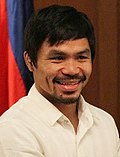 |
|---|
The 2016 Senate election in the Philippines occurred on May 9, 2016 to elect one-half of the Senate. The senators elected in 2016, together with those elected in 2013, comprise the Senate's delegation in the 17th Congress.
Contents
The proclamation of all the 12 senators was done ten days after Election Day, on May 19. three incumbents that ran successfully defended their seats, while four former and five new senators were elected.












